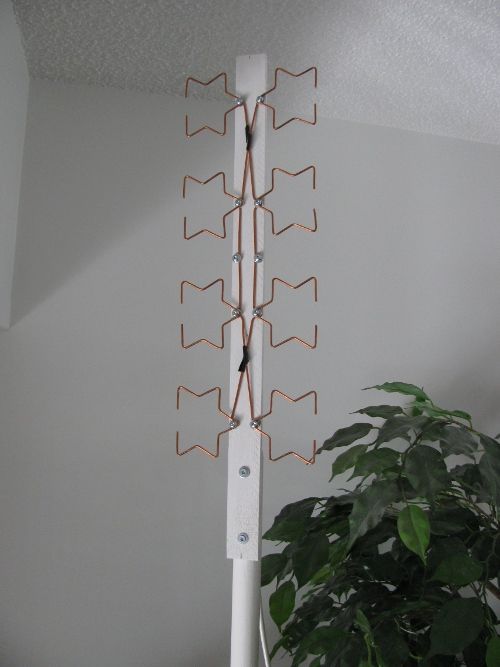
Cutting the Cord on Cable TV
Summary
This article describes how my spouse and I broke free from the chains
of analog cable TV and started on the path to a more satisfying media
entertainment solution.
We started on this path back in the Spring of 2011. The path we took
enabled us to record and watch local HDTV broadcasts on a home built
PVR, stream content over the Internet, and view DVDs of other shows
not available on our local TV broadcasts. We enjoy all of these media
viewing options while at the same time paying much less than a cable
TV subscription. Looking back (it is now two years later) we continue
to be very happy with our decision.
Contents
- Original TV Environment
- Cable TV Annoyances
- New Over-The-Air HDTV Broadcasts Coming
- TV Viewing Choices
- Build Over-The-Air HDTV Aerial
- Are Sufficient TV Shows Available via Local Broadcasts?
- Decision Going Forward
- Future Articles
Original TV Environment
In the years preceding our decision to "cut the cord" we enjoyed watching our favourite shows with the following TV environment:
- Sony Trinitron 32 inch Television
- Toshiba RD-XS35 Personal Video Recorder (PVR) with TVGOS
- Subscription to Analog Cable TV plus Internet
The Sony was a heavy 150 pound Cathode Ray Tube television that provided a decent picture for standard definition shows. Our cable TV subscription included the TV Guide On Screen (TVGOS) show listings that worked with the Toshiba PVR. TVGOS made it easy for us to pick a show from a list and record it with the PVR. All in all we were content with this setup, but changes were coming....
Cable TV Annoyances
All was not perfect with this TV setup. The things that annoyed us the most with our cable TV provider were the following:
- Steadily increasing subscription fees
- Reductions in the number of analog channels to make room for digital channels
- TVGOS signal drops lasting for days or weeks at a time
Paying more for less service grated us the wrong way.
Each time we called our provider to complain about the loss of TVGOS
signal, the representative had no clue what we were talking about.
They had no realization that there could be PVRs and TV listings
outside of what the cable TV provider offered.
The loss of TVGOS signal occurred frequently enough that a friend and
I figured out how to hook up a rabbit ear aerial so that we could
capture the TVGOS show listings by day, and then switch back to recording
TV shows at night. This was not a fool-proof solution though and
relied on manually switching between the cable TV feed and the aerial
feed. Needless to say we sometimes forgot to flip the switch which
would result in failing to record a TV show.
New Over-The-Air HDTV Broadcasts Coming
The time was Spring 2011 and several big changes were coming to television and broadcasting in Canada.
- TV Shows were switching from Standard Definition (SD) to High Definition (HD)
- Local TV stations were switching from Analog SD broadcasts to Over-The-Air (OTA) HD broadcasts.
In our area, the old-style analog broadcasts were not pleasant to watch due to issues with the image, such as ghosting. This was the main reason we subscribed to cable TV -- to get better quality images.
The deadline for all local TV stations to transition to OTA Advanced Television Systems Committee (ATSC) standards was August 31, 2011. Up until that date, local TV stations continued to broadcast the old analog SD signal, and could begin OTA ATSC signal broadcasting. These early OTA ATSC signal broadcasts provided us the ability to test the image quality before the drop dead date at the end of August.
TV Viewing Choices
With the upcoming changes in the television landscape we had some decisions to make.
Should we continue watching Standard Definition, or upgrade to High Definition?
We decided that we would upgrade to High Definition, so that prompted the purchase of a 40 inch Samsung HDTV (cost $500).
This led to us to the next question.
Should we upgrade our cable TV subscription to HDTV, switch to a satellite subscription, or try out an OTA HDTV aerial?
At about this time our cable TV provider provided a catalyst pushing
us into action. Specifically, they were increasing our subscription
fee to over $80 per month.
Before making any rash decisions we figured we would first test OTA
broadcasts.
Though we did not seriously consider it at the time, another choice for TV viewing is streaming TV shows through a service such as Netflix, or Hulu. Note that streaming TV shows might use up or exceed your monthly bandwidth allotment with your Internet service provider.
Build Over-The-Air HDTV Aerial
To determine the type of aerial required for the TV stations
available in our area we consulted the following link:
TV Fool
To access relevant information, provide an address or postal code.
This site also displays where our local TV station broadcast towers
were in relation to our location. This can help you point your
aerial for the best reception.
For our location we learnt that all we needed was a basic TV aerial.
Not wishing to spend lots of hard-earned cash, we chose to build a clothes hanger aerial that we had learnt about on the Internet.

The instruction video my father and I watched to make this aerial can
be found at the following link:
Coat Hanger HDTV Antenna
The clothes hanger aerial proof-of-concept demonstrated that we could receive clear HDTV images at our location.
Though we used this clothes hanger aerial for a short while, this aerial has pointy ends that we did not like. Consequently my spouse researched aerial design and built us an optimal four bay star aerial that would be less likely to poke anyone in the eye.

This new aerial is much more pleasing to the eye *pun intended* and provides us with reliable, clear HDTV reception. In fact my spouse has built a few for friends and family, and my father even made a jig for creating the star pattern.
Note: For those that already have a rabbit ear aerial, you can use your existing aerial to test if you receive clear OTA HDTV broadcasts at your location. You might need to play around with the aerial length, the angle between the "ears", and the direction to get the best reception.
Are Sufficient TV Shows Available via Local Broadcasts?
With the realization that OTA HDTV broadcasts were a distinct
possibility for us we needed to address the next question:
Was there sufficient programming available?
To answer this question we needed a list of shows that we regularly
watch. Fortunately for us this was available on our Toshiba PVR in
the list of recording rules.
Upon reviewing the recording rules, it turned out that about 90% of
the shows we watched were available on the local TV stations. There
was a nature show and a car show on PBS that we would miss. There
were also some home improvement shows on HGTV that we occasionally
watched that we would miss, but overall we felt we could live without
these shows. If we really missed some TV shows then we could consider
buying a DVD containing the complete season.
Decision Going Forward
After considering all of the above, we committed to a path to wean
ourselves off cable TV and migrated to a new media viewing solution
that included local HDTV broadcasts.
Note: When we contacted our cable TV provider to drop TV service, they
told us that our Internet rate would increase. We tried to negotiate
but the cable TV provider would not budge. Consequently we changed
our Internet service over to a similar plan with our telephone
provider. This resulted in a savings of $50 per month, or $600 per
year.
Future Articles
In future articles, I plan to cover the following steps of our path:

